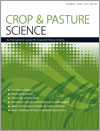Chickpea (Cicer arietinum L.) is an important food legume and heat stress affects chickpea ontogeny over a range of environments. Generally, chickpea adapts to high temperatures through an escape mechanism. However, heat stress during reproductive development can cause significant yield loss. The most important effects on the reproductive phase that affect pod set, seed set and yield are: (1) flowering time, (2) asynchrony of male and female floral organ development, and (3) impairment of male and female floral organs. While this review emphasises the importance of high temperatures >30°C, the temperature range of 32–35°C during flowering also produces distinct effects on grain yield. Recent field screening at ICRISAT have identified several heat-tolerant germplasm, which can be used in breeding programs for improving heat tolerance in chickpea. Research on the impact of heat stress in chickpea is not extensive. This review describes the status of chickpea production, the effects of high temperature on chickpea, and the opportunities for genetic improvement of chickpea tolerance to high temperatures.
How to translate text using browser tools
9 July 2012
High temperature tolerance in chickpea and its implications for plant improvement
V. Devasirvatham,
D. K. Y. Tan,
P. M. Gaur,
T. N. Raju,
R. M. Trethowan
ACCESS THE FULL ARTICLE

Crop and Pasture Science
Vol. 63 • No. 5
August 2012
Vol. 63 • No. 5
August 2012
genetic variation
legumes
pollen
semi-arid tropics
tolerance




